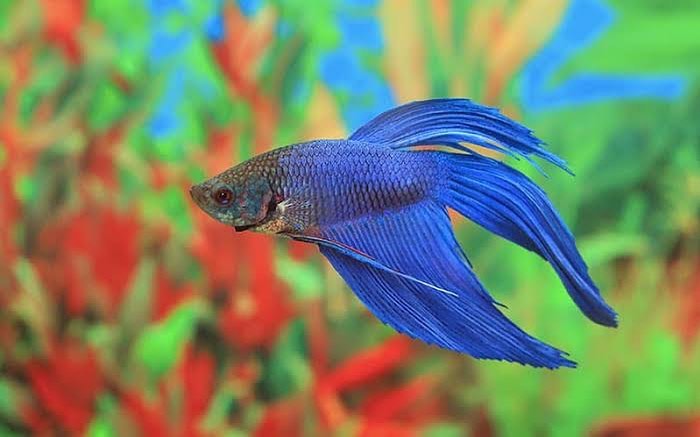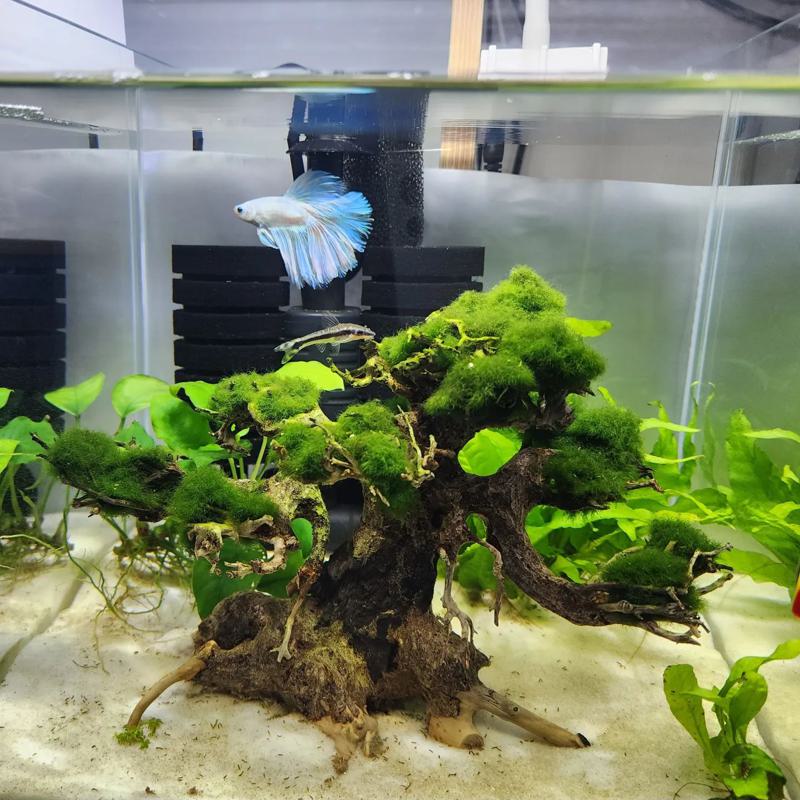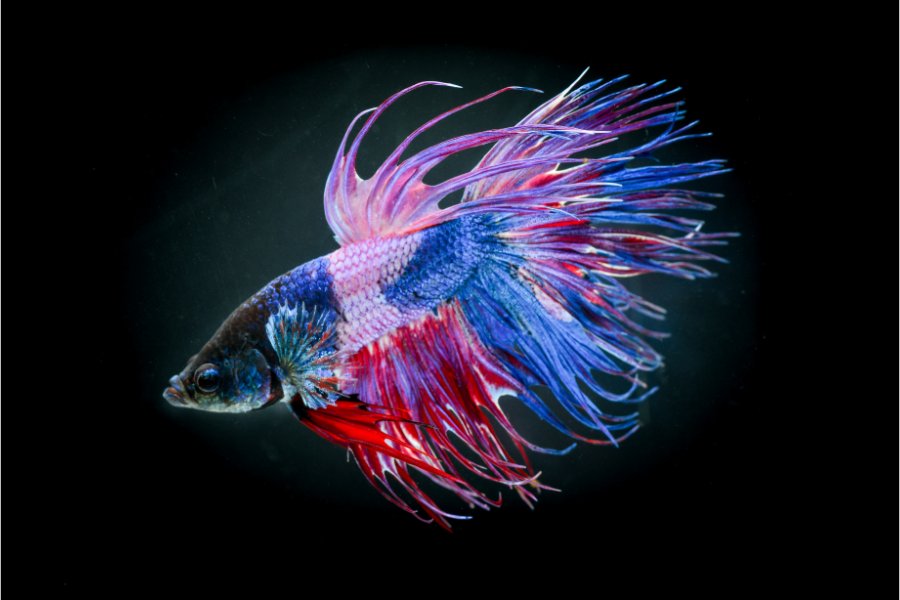Betta fish have been a staple in the aquarium hobby. Due to their popularity and availability, variations in tank setup have evolved.
Some betta tanks are large, while others are small (like a fish bowl). Some are adorned with embellishments (like plastic decorations), while others use live aquatic plants. Some tanks are compartmentalized with no decoration at all.
While the variations in betta fish tanks are endless, what caught my attention is some tanks have bubblers while others don’t.
Which is which? What do you think?
Join us in this article as we examine if betta fish need bubblers and other forms of aeration systems.
The Labyrinth Apparatus of Betta Fish
Betta fish are anabantoids. They belong to a group of fish with air-breathing organs called the labyrinth apparatus. It allows them to gulp in the air and extract oxygen directly from the atmosphere.
The labyrinth apparatus compliments the gills (which also extract oxygen in the water), and their combination makes betta fish adaptable even in hypoxia or waters with little oxygen.
When the dissolved oxygen level drops, your betta fish responds by swimming to the surface. They gulp in the air, extract the oxygen using the labyrinth apparatus and circulate it in the bloodstream. It is also why betta fish can survive out of the water for some time.
Take note that the labyrinth apparatus is not functional upon birth. Juvenile betta fish rely on their gills for breathing. As the fish grow, the labyrinth apparatus develops and becomes fully functional when they reach maturity.
Understanding the Functionality of a Bubbler
As the name suggests, bubblers emit bubbles. They are made from a porous material that requires a hose and a pump to function.
When the pump is turned on, air travels to the hose and exits to the pores of the bubbler in the form of bubbles. Before the development of bubblers, air from the pump freely exits the hose creating loud and large bubbles. With bubblers, the bubbles are smaller and quieter.
But what makes a bubbler important is not the quiet bubbles they produce. It has something to do with how they create vertical water movement allowing gas exchange to occur at the surface.
Bubblers are not used primarily to create water movement. While they do, the target is to create gas exchange on the surface.
As the bubbles ascend and reach the surface, they pop out. As they burst, it releases toxic carbon dioxide gasses stored in the aquarium tank in exchange for a fresh supply of oxygen.
Now that we know betta fish can breathe in the water and from the air, do they still need bubblers?
Conditions that DON’T Require a Bubbler

There are conditions that a bubbler can do more harm than good to your betta fish. Therefore, a bubbler is not necessary for these conditions:
Good Water Flow
A good water flow means it should move the surface water and allow the exchange of gasses.
In the absence of a bubbler, water movement decreases. But it doesn’t mean that water movement is solely dependent on bubblers.
There are ways to circulate water without using bubblers or an air pump. You will learn this in the upcoming section.
Adequate Tank Space
The larger the tank, the better.
Aside from having a bigger space for swimming, large tanks carry more water, which holds more dissolved oxygen.
However, using a large tank doesn’t mean you can place more fish than usual.
Minimal Residents
The lesser, the better.
Each fish you place in the tank consumes dissolved oxygen. The more fish you keep, the faster your dissolved oxygen is consumed.
As with betta fish, they are commonly kept in solitary confinement due to their aggressive behavior. If your betta fish is alone in the tank, then a bubbler is not necessary.
Frequent Water Change
Water change is an integral part of aquarium maintenance. Aside from supplying it with new water that has fresh content of dissolved oxygen, you are also discarding an amount of toxin stored in the tank.
If you frequently change the water, there is no need for a bubbler. The fresh supply of dissolved oxygen from the new water will suffice.
When Do Betta Fish Need a Bubbler?

The main thing to consider in using a bubbler for your betta fish is when dissolved oxygen is compromised. Unfortunately, some conditions or events can deplete or lessen the amount of dissolved oxygen, and thus a bubbler is required.
Additional Tank Residents
Due to their aggressive behavior, betta fish are often kept alone in the tank. However, some species are compatible and can coexist with betta fish.
With more fish added, expect your dissolved oxygen will run out faster. In this case, a bubbler provides a steady supply of dissolved oxygen and prevents sudden depletion.
Warm Water and Weather
Temperature dictates the amount of dissolved oxygen water can hold. In general, cold water has more dissolved oxygen than warm water.
For betta fish, their ideal water temperature ranges from 75 – 80 OF (24 – 27 OC). Anything warmer means a lower dissolved oxygen level and requires a bubbler.
However, it does not mean that you keep your water constantly cold. Cold water slows a betta fish’s immune system making them susceptible to diseases.
Similarly, weather affects room temperature, which also influences tank water temperature. For example, winter significantly lowers water temperature, and a heater becomes a tank essential.
Stay within the recommended temperature range.
Indications that My Betta Fish Need More Oxygen
We now know when to use and not use a bubbler with our betta fish. Yet, on some occasions, the dissolved oxygen level is unstable.
With this, your ultimate indicator will be your betta fish behavior. Often these indications will give you a real-time idea of the current dissolved oxygen level.
Gill and Body Motion
Even if betta fish have the labyrinth apparatus that allows them to breathe from the air, their gills are still their primary organ for breathing.
If the gills of your betta fish are rapidly flapping or motionless, it indicates your fish is struggling for oxygen. However, be careful with observing this indicator. Being motionless (both on the gills and their body) is a common habit of betta fish.
Do not worry if the gills of your betta fish are not moving for a few minutes. However, if the motionless body and gill movement persists for hours, then be prepared to add the bubbler. It is a clear indicator that the dissolved oxygen level is low.
Expect changes in behavior once you add the bubbler. After a few minutes, your fish should start swimming with their gills flapping.
Otherwise, if motionlessness prevails, you should suspect illness in the form of bacterial infection. Consult a veterinarian and treat accordingly.
Gasping for Surface Air
The instinct of betta fish when dissolved oxygen is low is they swim to the surface and gasp for air. It is where their labyrinth apparatus comes into function.
Add bubblers the moment you see your betta fish gasping for surface air.
If you are not confident in using the behavior of your betta fish as an indicator of low dissolved oxygen, then you will not go wrong with using a DO meter. This digital instrument reads the actual dissolved oxygen content of your water.
The ideal dissolved oxygen content for betta fish ranges from 5 to 7 ppm.
Natural Aeration Techniques Without Bubblers
With a few steps to follow, you can get rid of bubblers and use natural ways to aerate your water.
Addition of Live Plants

Through photosynthesis, plants produce oxygen.
Adding live aquatic plants is a win-win situation for your betta fish. Aside from increasing tank aesthetic beauty, they also extract toxic carbon dioxide from the water.
Be aware that there are misconceptions about live aquatic plants and be misused in producing oxygen.
A common misconception is that live aquatic plants produce sufficient dissolved oxygen. They do produce oxygen but again will depend on their photosynthetic activity.
Their oxygen production may not also suffice for a tank with more fish. Add the corresponding quantity of plants according to the density of the fish population.
The correct type of aquatic plants will also influence dissolved oxygen levels. Do not use surface floating plants. They obstruct and limit the surface area where gas exchange occurs.
Use vertical standing plants that stay at the bottom, like Anubias, Java fern, Vallisneria, and dwarf hairgrass.
Provision of Large Surface Area
The larger the surface area exposed to the air, the more oxygen dissolved. It is why we do not recommend surface floating plants.
Keep Fish Swimming at Different Levels
Fish can be an asset in water movement. Remember that fish swim by swaying their fins, creating water movement. When you have fish swimming at different levels, then you are guaranteed stagnant water will not occur.
The combination of a bottom feeder, a middle swimmer, and a surface dweller will do.
But again, do not overstock and only keep fish compatible with betta fish.
Also Read:
- Do Betta Fish Need Air Pumps?
- Do Goldfish Need an Air Pump?
- How Does a Sponge Filter Work?
- Betta Fish Tank Setup: What to Put In?
- Why Fish Jump out Of Tank
- Do Betta Fish Need Light?
FAQs
Do Bubblers Supply Oxygen?
No. What is emitted out of the bubbler is air coming from the pump. Oxygen is only diffused in the water when trapped air in the bubbles ascends and pops out at the surface, allowing gas exchange.
Are Bubbles Bad for Betta Fish?
Large bubbles disrupt the behavior of your betta fish.
When an air hose is not attached to a bubbler, bubbles will freely flow out with all their might causing your betta fish to struggle.
Similarly with bubblers, if the flow of tiny bubbles is strong, it can disrupt your betta fish. Adjust the flow accordingly so emitted bubbles are calm and gentle.
What Is the Longest Time a Betta Fish Can Survive out Of the Water?
6 to 8 hours.
Betta fish originated from the rice paddies and shallow marshes in Thailand. During the dry season, the water of these pools depletes, exposing the betta fish to dry land.
Conclusion
Betta fish do need bubblers. However, not on all occasions. The use of bubblers in keeping betta fish will always depend on the situation.
If the situation requires a bubbler, then use one. However, if it doesn’t, then don’t. You may do more harm to your betta fish. And what’s best without using bubblers is you save on electrical costs.
